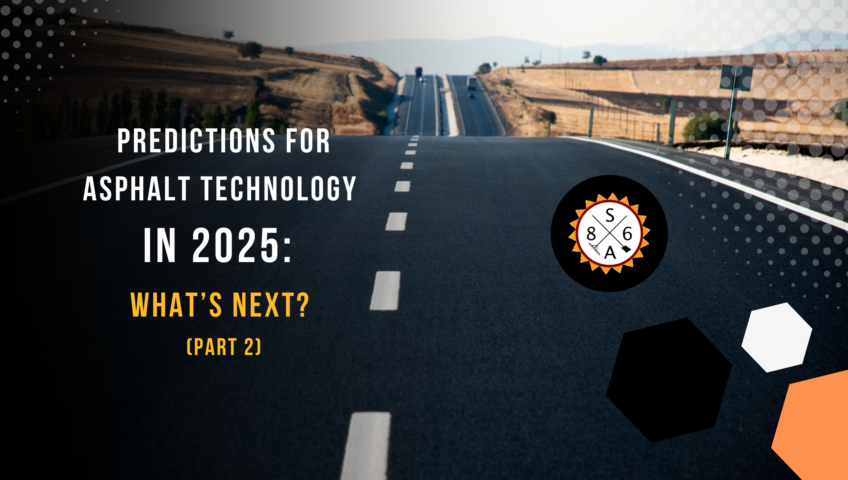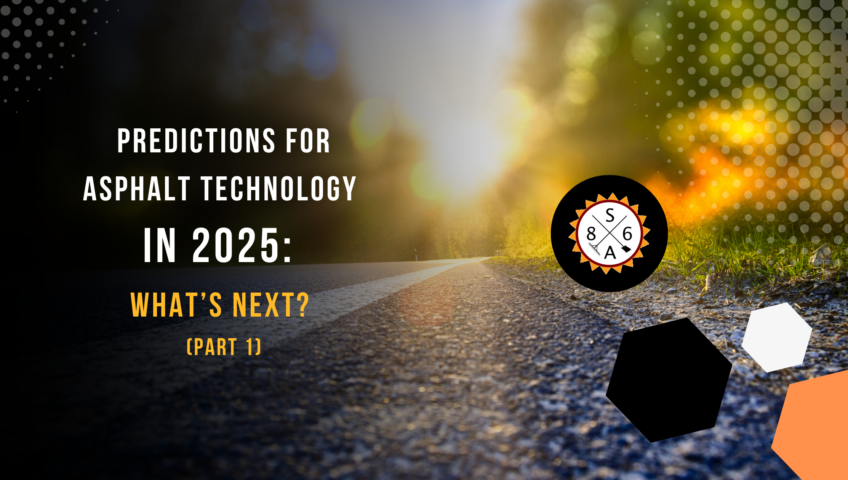
Predictions for Asphalt Technology in 2025: What’s Next? (Part 2)
Asphalt has been the backbone of global infrastructure for over a century, but today’s challenges demand more than just a simple, durable surface. In an era defined by climate change, urbanization, and the relentless pursuit of sustainability, the asphalt industry is undergoing a transformation. By 2025, the technological advances driving this change will not only reshape how roads are built and maintained but also redefine their role in modern society. From energy-harvesting surfaces to roads that repair themselves, the asphalt innovations of 2025 promise to make our streets smarter, more resilient, and environmentally friendly. This forward-looking approach to asphalt technology could change the future of transportation and urban planning as we know it.
7. Enhanced AI and Machine Learning in Paving Operations
Artificial intelligence and machine learning will play an even larger role in asphalt paving operations by 2025. These technologies will help optimize everything from material selection to paving techniques, ensuring that every aspect of road construction is efficient and sustainable.
AI will be used to analyze vast amounts of data related to traffic patterns, weather conditions, and material performance, providing engineers with insights on the best types of asphalt to use for specific projects. This data-driven approach will result in longer-lasting roads that require less maintenance, reducing costs and environmental impact over time.
Moreover, AI-powered paving equipment will become more common, automating tasks like compaction and temperature control. These machines will be able to adjust on the fly to ensure optimal paving conditions, resulting in smoother, more durable roads.
8. Widespread Use of Nano-Enhanced Asphalt
Nanotechnology is expected to play a growing role in the asphalt industry by 2025. Nano-enhanced asphalt incorporates nanoparticles that can improve the material’s strength, flexibility, and resistance to weathering. These nanoparticles, which could be made from materials like carbon nanotubes or silica, are designed to strengthen the asphalt matrix, making the pavement more resistant to cracking and deformation.
By 2025, nano-enhanced asphalt may become a common choice for high-traffic areas, such as highways, airports, and major urban roads. The superior durability of these pavements will reduce the need for frequent repairs, saving municipalities and taxpayers money while minimizing traffic disruptions.
9. Wider Implementation of Permeable Asphalt
Permeable asphalt, which allows water to pass through the pavement and into the ground, is already making waves as a sustainable solution for stormwater management. In 2025, we will likely see even wider implementation of this technology, especially in areas prone to flooding or where stormwater management is a major concern.
As climate change leads to more intense rainfall, cities will turn to permeable asphalt as part of their green infrastructure initiatives. Improvements in the durability and load-bearing capacity of permeable asphalt will make it a viable option for more high-traffic areas, further expanding its use beyond parking lots and driveways.
10. Asphalt with Embedded Wireless Charging
As electric vehicles (EVs) become more popular, the demand for innovative infrastructure to support them will grow. By 2025, we may see the first large-scale installations of roads embedded with wireless charging technology. Asphalt that includes wireless charging pads could allow EVs to charge as they drive, eliminating the need for long stops at charging stations.
This technology is still in its infancy, but by 2025, advancements in wireless power transfer systems and road-embedded sensors could make this concept a reality. If successful, wireless charging asphalt could play a critical role in the widespread adoption of electric vehicles by providing a seamless charging experience.
Conclusion
As we approach 2025, the future of asphalt is set to be brighter, more sustainable, and increasingly intelligent. From the integration of energy-generating and self-healing technologies to the wide adoption of AI-driven predictive maintenance and carbon-negative materials, the roads of tomorrow will serve as much more than mere pathways for vehicles. They will become sustainable energy sources, contribute to environmental protection, and support the transition to autonomous driving and electric vehicles. These innovations in asphalt technology are not just incremental improvements—they represent a radical shift toward a smarter, greener infrastructure that can adapt to the evolving needs of both cities and the planet. In 2025 and beyond, asphalt won’t just pave roads; it will pave the way for a more sustainable and technologically advanced future.
Asphalt has been the backbone of global infrastructure for over a century, but today’s challenges demand more than just a simple, durable surface. In an era defined by climate change, urbanization, and the relentless pursuit of sustainability, the asphalt industry is undergoing a transformation. By 2025, the technological advances driving this change will not only reshape how roads are built and maintained but also redefine their role in modern society. From energy-harvesting surfaces to roads that repair themselves, the asphalt innovations of 2025 promise to make our streets smarter, more resilient, and environmentally friendly. This forward-looking approach to asphalt technology could change the future of transportation and urban planning as we know it.
7. Enhanced AI and Machine Learning in Paving Operations
Artificial intelligence and machine learning will play an even larger role in asphalt paving operations by 2025. These technologies will help optimize everything from material selection to paving techniques, ensuring that every aspect of road construction is efficient and sustainable.
AI will be used to analyze vast amounts of data related to traffic patterns, weather conditions, and material performance, providing engineers with insights on the best types of asphalt to use for specific projects. This data-driven approach will result in longer-lasting roads that require less maintenance, reducing costs and environmental impact over time.
Moreover, AI-powered paving equipment will become more common, automating tasks like compaction and temperature control. These machines will be able to adjust on the fly to ensure optimal paving conditions, resulting in smoother, more durable roads.
8. Widespread Use of Nano-Enhanced Asphalt
Nanotechnology is expected to play a growing role in the asphalt industry by 2025. Nano-enhanced asphalt incorporates nanoparticles that can improve the material’s strength, flexibility, and resistance to weathering. These nanoparticles, which could be made from materials like carbon nanotubes or silica, are designed to strengthen the asphalt matrix, making the pavement more resistant to cracking and deformation.
By 2025, nano-enhanced asphalt may become a common choice for high-traffic areas, such as highways, airports, and major urban roads. The superior durability of these pavements will reduce the need for frequent repairs, saving municipalities and taxpayers money while minimizing traffic disruptions.
9. Wider Implementation of Permeable Asphalt
Permeable asphalt, which allows water to pass through the pavement and into the ground, is already making waves as a sustainable solution for stormwater management. In 2025, we will likely see even wider implementation of this technology, especially in areas prone to flooding or where stormwater management is a major concern.
As climate change leads to more intense rainfall, cities will turn to permeable asphalt as part of their green infrastructure initiatives. Improvements in the durability and load-bearing capacity of permeable asphalt will make it a viable option for more high-traffic areas, further expanding its use beyond parking lots and driveways.
10. Asphalt with Embedded Wireless Charging
As electric vehicles (EVs) become more popular, the demand for innovative infrastructure to support them will grow. By 2025, we may see the first large-scale installations of roads embedded with wireless charging technology. Asphalt that includes wireless charging pads could allow EVs to charge as they drive, eliminating the need for long stops at charging stations.
This technology is still in its infancy, but by 2025, advancements in wireless power transfer systems and road-embedded sensors could make this concept a reality. If successful, wireless charging asphalt could play a critical role in the widespread adoption of electric vehicles by providing a seamless charging experience.
Conclusion
As we approach 2025, the future of asphalt is set to be brighter, more sustainable, and increasingly intelligent. From the integration of energy-generating and self-healing technologies to the wide adoption of AI-driven predictive maintenance and carbon-negative materials, the roads of tomorrow will serve as much more than mere pathways for vehicles. They will become sustainable energy sources, contribute to environmental protection, and support the transition to autonomous driving and electric vehicles. These innovations in asphalt technology are not just incremental improvements—they represent a radical shift toward a smarter, greener infrastructure that can adapt to the evolving needs of both cities and the planet. In 2025 and beyond, asphalt won’t just pave roads; it will pave the way for a more sustainable and technologically advanced future.




